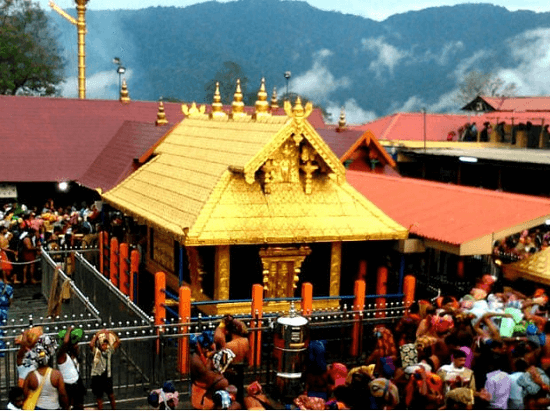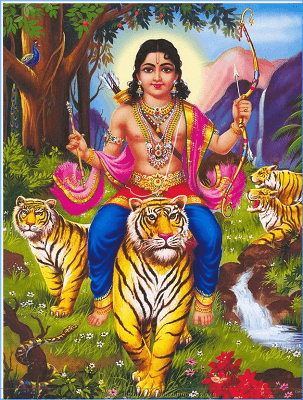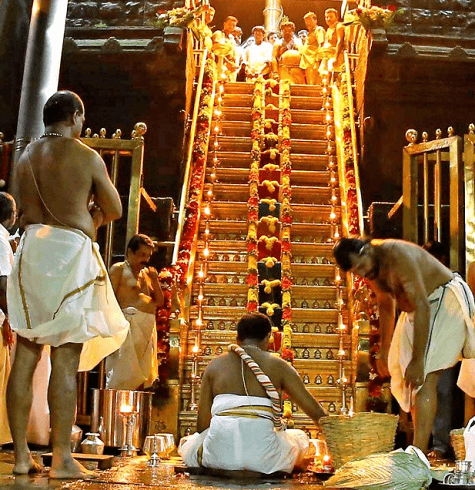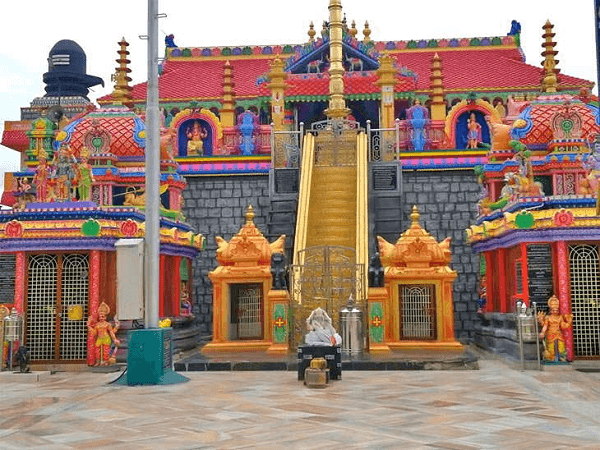Sabarimala TempleSabarimala temple is a Hindu temple of the god Ayyappan, also named Shasta or Manikandan. Annually 40 million pilgrims come here from around the world. It is one the most sacred place among followers of Hinduism, majorly in the southern part of India. This pilgrimage site is regarded as the conflux point of two main groups of Hinduism- Shaivism, and Vaishnavism because God Ayyappan is believed to be the progeny of Lord Shiva and Lord Vishnu. 
LocationSabarimala temple is in the Perinad Village of the Pathanamthitta district of Kerala, India. It is at the Sabarimala Hill, 1260 m above sea level, near Periyar Tiger Reserve in Poongavanam Forest. How to ReachOne can reach Sabarimala temple from all modes of transport. Firstly, one has to reach a place called Pampa in Sabarimala. From Pampa, there is a walk of 5 km through the forest, and after the trek of 1535 feet of a high hill, one can have the darshan of Shri Ayyappan. The walking and trekking route to Sabarimala temple is very developed with shops, emergency health facilities, doli services, etc. Different ways to reach PampaBy Railways The nearest railway stations from Pampa are Kottayam (92km), Tiruvallur (87 km), and Chengannur (82 km). Trains for these stations are easily available. By Airways Thiruvananthapuram airport and Kochi Airport, which are 170 km and 160 km, respectively, are the nearest airports from Pampa. There is also a Heliport service available in Perunad for Pampa, which is 40 km away from Pampa, called Sabarimala Helipad. By Roadways Bus services are available from Eruneli, Kottayam, Chengannur, Coimbatore, Pandalam, and Kumili every day. A chain service is also available between Pampa and Nilachal base camps. About Lord AyyappanHow He Became The GodThere was a demon named Mahisasur, who was very brutal and was killing God's community. Then all of them requested Maa Durga to kill Mahisasur, which she did, as she herself was the Shakti (the power). This story related to Maa Durga and Mahisasur is known to most of us. But this was not the end; from here, another story starts. Mahisi, a female demon, is regarded as the wife of Mahisasur in some mythological texts, whereas the sister of Mahisasur is in some texts. She was very upset with the killing of Mahisasur, and she pledged to take revenge for the killing and started penance. Through her penance, she pleased Lord Brahma. When Lord Brahma appeared before her, he asked her to tell him her wish. She demanded to make her immortal. Lord Brahma refused her wish by saying that it is against nature, he can't approve of it and gave her the option that she can choose the way of her death. Then she agreed and asked Brahma Ji that grant her wish that she could be killed only by the child of Lord Shiva and Lord Vishnu, which she thought that it was impossible because both of them were male, and two males can't give birth to a child. Now, she thought that she could not die and started her revenge by killing God's community, and her threat spread everywhere; everyone in Swarg Lok was in Panic. Then, all of them went to Lord Vishnu for help. Lord Vishnu took his female avatar as Mohini and went to Lord Shiva, and then Shiv Ji gave his seed to Mohini without any intimacy. With that, Mohini got pregnant and, after some time, gave birth to a boy child; he was the god Ayyappan. After that, Lord Shiva told Mohini that this boy child would be taken care of by his devotee, who was the King of Pandalam, King Rajasekhar; he did not have any child at that time. Then Mohini left this child in a basket by tying a golden bell to his neck in the Pampa River. King Rajasekhar found this child with a golden bell and named him Manikandan. He was named Manikandan because of that golden bell on his neck, as Mani means golden bell and Kandan means neck. As time passed, he grew, and the queen also gave birth to a child. But the queen started to feel that after the king, Manikandan would become the king, not his own child, and she started getting jealous of him. One day she did a conspiracy and acted like she was ill, Vaidya was called, and he, under the direction of the queen, told her that only the milk of the tigress of the forest could cure the queen. Hearing this, 11-year-old Manikandan agreed to go to the forest; they succeeded in their plan and thought that Manikandan would die. Little Manikandan went to the forest, where he met the demon Mahisi, who cordoned there for him, then Manikandan and Mahisi fought with each other, and finally, she was killed by him. After that, all the tiger and tigress bowed down to him, and he came back to his palace, sitting on the back of the tigress. This incident envisaged everyone that Manikandan is not a normal boy but an incarnation of God. 
After that, it is said that one day he came in the dream of his father, king Rajshekhar, and asked him to build a temple in the hills of Sabarimala. On God Manikandan's order, the king built the temple of Ayyappan, which we know as the Sabarimala temple. Shasta has been worshipped for a long-ago in south India and has been a part of its tradition. Lord Manikandan is believed to be the avatar of Shasta. It is also said that Lord Parshuram set up five Shasta in the world, and this Ayyappan temple is one of them. Here Lord Ayyappan is in the form of Naistika Brahmachari (also known as Vanaprastha) means an unmarried virgin. This is the reason women between the age group of 10- 50 years were not allowed inside the temple. Inside the TempleThe main temple where Lord Ayyappan resided is known as Sannidhanam, built on a 40ft high plateau. The sanctum has a gold plated roof with four golden hip-knobs at the top, the place of altar called balikapura, and two mandapam. The deity of Ayyappan is made of Panchaloha (a mix of 5 metals). Other than that, in the southwest of Sannidhanam, there is Kannimoola Ganapathi Prathishta, devoted to Lord Ganesh. After that, there is Pathinettu Thripadikal, also known as the 18 sacred steps, going to the temple. At the foot of this stepway, there are two guards, namely Karuppu Sami and Kadutha Sami, both of them are lieutenants of Lord Ayyappan. There is another very important temple near Sannidhanam is the temple of Maalikapurath amma, set up by Brahmashree Kandararu Maheshwararu Thanthri. It is said that Maalikapurath amma was the daughter of Cheerappanchira, who taught Kalaripayattu to Lord Ayyappan. Other temples include the Nagarajav shrine, Pampa Ganapathi temple, Palliyara Bhagavati temple, and Nilakal Mahadeva temple in the complex. Manimandapam is the place of Jeeva Samadhi of Lord Ayyappan. When to go to SabarimalaThe Sabarimala temple is not opened throughout the year. There are some specified periods and days when the temple is open for devotees, like during the period of Mandalapooja (between 15 November to 26 December), the longest time for which the temple is open for worship. Other than that, it opens on Makar Sankranti (14 January), Maha Thirumal Sankranti (14 April), and lastly, the first 5 days of each month of the Malayalam Calendar. Timings- In the morning, the sanctum opens at 3 AM and closes at 1 PM, while in the evening, it remains open from 3 PM to 11 PM. Special Religious Practices in the TempleNeyyabhishekamIt is the auspicious practice of God Ayyappan. This coconut filled with ghee is collected from the devotees, and all the ghee is poured into a container; then, the Guru Swamy of the temple offers this ghee to Lord Ayyappan, and after that, a part of the ghee is given to devotees as prasadam. In the whole process, the Lord Ayyapan, the ghee, and the coconut signify a very serious aspect of life. Lord Ayyappan is regarded as Paramatma; the ghee is the Jeevatma, and the empty coconut, after pouring the ghee, signifies the dead body, and the process of pouring ghee on the means meeting of Jeevatma with Paramatma. The cost for performing Neyyabhishekam is Rs. 10 only. Padi Pooja
It is the pooja in which the 18 sacred steps are decorated with Pushpa(flowers), and silk apparel and diyas are lighted and end with aarti. It happens on special days, after Pushpabhishekam of Lord Ayyapan. The pooja fee for Padi Pooja is the highest - Rs. 75,000 /- Udayasthamana PoojaUdayasthamana means dawn to dusk, which means this pooja is done right from dawn to dusk, apart from the everyday routine pooja. A total of 18 poojas are conducted in Udayasthamana Pooja. The fee charged for this pooja is Rs. 40,000/-. KalasamsIt includes various types of abhishekam in it, like
The Secret of 18 Holy steps
These 18 holy steps are originally named Pathinettu Thripadikal. It is the main way to enter into the Lord Ayyapan sanctum sanctorum. According to the tradition of the temple, the only pilgrim who is following Irumudikkettu is allowed to use these steps. Those who do not follow Irumudikkettu have to go through another gate on the northern side. Irumudikkettu is a special ritual or vratam that starts 41 days before entering the temple. In this, one has to follow strict rules and lead a disciplined life. That person has to maintain celibacy and teetotalism. He should have a vegetarian diet and have to take a bath twice a day and go to the nearby temple every day. He can wear only black or blue clothes and remain barefooted during this period. The most important thing, he has to control his anger and other wrong feelings and treat other people very nicely like the other person is Lord Ayyappan himself. Reaching Sabarimala temple is hard but worth visiting.
Next TopicVrindavan Temples
|
 For Videos Join Our Youtube Channel: Join Now
For Videos Join Our Youtube Channel: Join Now
Feedback
- Send your Feedback to [email protected]
Help Others, Please Share










